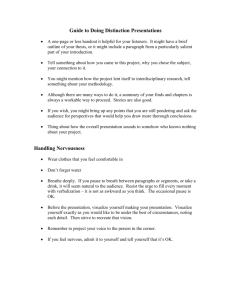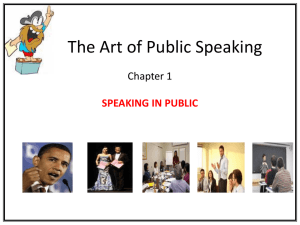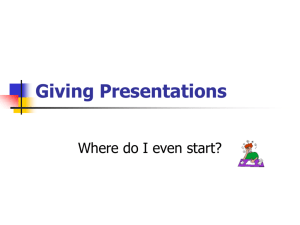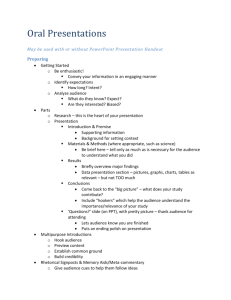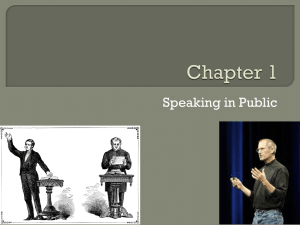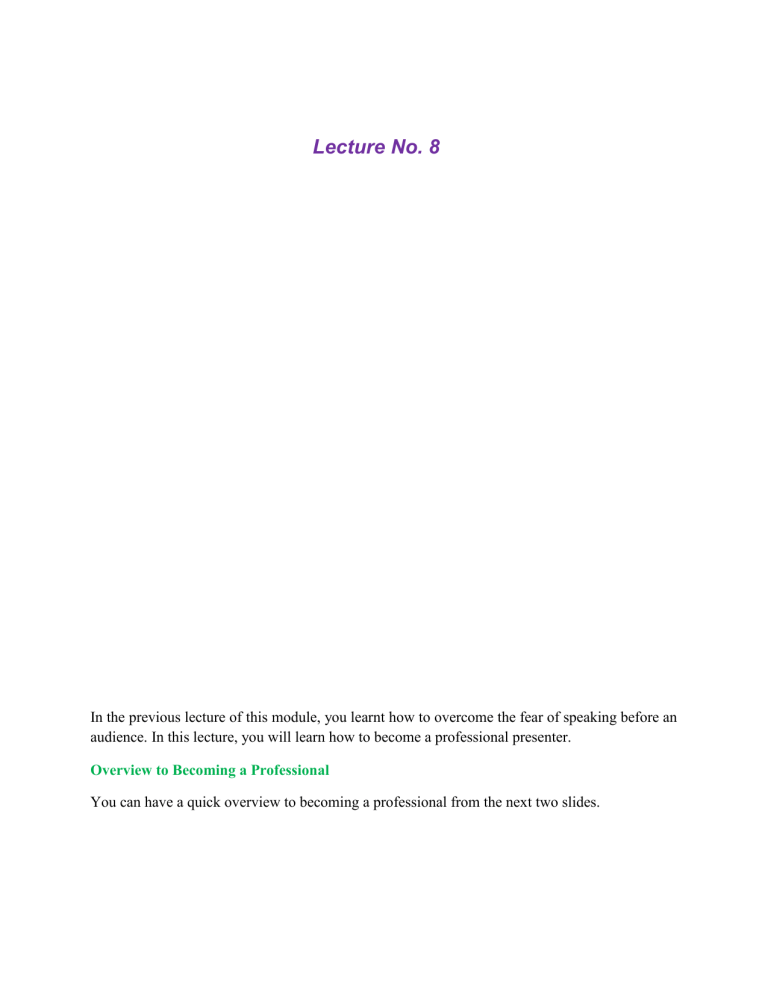
Lecture No. In the previous lecture of this module, you learnt how to overcome the fear of speaking before an audience. In this lecture, you will learn how to become a professional presenter. Overview to Becoming a Professional You can have a quick overview to becoming a professional from the next two slides. Now let me further elaborate on these points. View the Venue It is human nature to feel a little nervous at an unknown place. So in order to gain confidence, psychologically, it is important that you preview the venue where you are going to give the presentation. Try to go the conference room, auditorium or wherever your presentation is scheduled a day before. If a day before is not possible, be there few hours before. In the worst case, you should be there at least before the arrival of the audience. Take note of the gates from which audience will enter. Decide, if you want control, whether you want some gates to be closed in advance. You can also choose to let the audience through only one entrance where you can be present to greet them. Familiarize yourself with the room fully by walking all over. Then, sit on one of seats from the corner row. Come to the front row and sit somewhere on the middle. Keep varying, keep walking, and once you feel that you are familiar with the room, go to the stage. Like professional drama artists, you need to have a complete rehearsal of your speech (especially if you are going to deliver it for the first time). While trying for a rehearsal, you can also check the audio/video system. If you have a copy of your presentation on a CD or pen drive, you can load it on the computer and check for compatibility issues. All these small checking before the presentation will ensure in giving you the much needed confidence. Once you are satisfied with your checking, you will automatically feel that you are prepared for your presentation. You may feel bit anxious at this stage too: but don’t worry, this is normal and expected. The anxiety comes in anticipation of the excitement you are going to have during the presentation. Since, it is a positive force you can let it linger. Welcome the Viewer Before the audience enter, you should be there to welcome them. Greet the audience as they arrive; smile and maintain eye contact. If you are a beginner, you will realize that it will be easier to smile now as they come one by one than later when you look at all of them together. If the audience is less in number, you can shake hands with them. You can also ask informal questions like what motivated them to come for the lecture, why they are interested in your topic, what they are expecting from your speech. You may even get some very positive and encouraging remarks even before you start. This will also help you to size up the audience and learn about what they know already. Apart from this, it will also help you to create a friendly atmosphere and neutralize any animosity at the start itself. Keep your audience in mind at all times. For example, be sure the data you present is clear and the information you give is relevant. Keep the level of detail and vocabulary appropriate for the audience. Don’t hesitate to use visuals to support key points or steps. Be alert and sensitive to the needs of your listeners, and you will have a more receptive and appreciative audience. Master Your Material You should know your subject matter thoroughly. It’s not just enough that you borrowed material from somebody and assimilated it to suit your purpose. It’s important that you know it in and out. Consider the amount of time available and prepare to organize your material. Narrow your topic. Divide your presentation into clear segments. Follow a logical progression. Maintain your focus throughout. Close the presentation with a summary, repetition of the key steps, or a logical conclusion. If you are thorough with the material, you will not fear facing any embarrassing questions from the audience. It will also help you to calm your nerves. Calm Your Mind You should also engage yourself in exercises to release tension. For instance, you can take deep breath, and then, keep inhaling and exhaling the air slowly. The so called rowing technique suggests that when you exhale and inhale, you should move your hands and elbow back and forth like the way you row a boat. Some people find doing yoga and practicing meditation on a regular basis help in calming the mind in critical situations. Visualize Yourself Speaking Success is achievable if you visualize; hence, visualize yourself delivering a powerful speech, and imagine that the audience receive it with roaring applause. Realize that people after all want a winning leader; so, generally, the audience want you to succeed—not fail. They want the speaker to take lead, tackle viewers, and handle difficult questions with aplomb. Avoid Apologies Never begin your speech with an apology for lack of adequate preparation or for your nervousness. You never know how the audience received your presentation. Perhaps, despite your nervousness and less preparation, you might end up giving a good presentation. By apologizing, on the one hand, you are presuming audience’s response, and on the other, you are preconditioning their minds to think of you in a poor light. Focus on Your Message Once you confidentially begin your presentation, focus on your message not the medium. Do not nurture anxieties but concentrate on your message. Avoid bothering about grammatical mistakes and slips in pronunciation and concentrate on the subject matter. The audience actually are not interested in the kind of language that you use. They are interested only in the message of your presentation. As long as you have a strong message to deliver, you don’t have to worry about the way it will be delivered to the audience. Turn Nervousness into Positive Energy Instead of looking at nervousness as a problem source, you need to perceive nervous energy as an asset to you. Learn to harness it, and transform it into vitality and enthusiasm. Gain Experience Jump at any slight opportunity to give oral presentation. Volunteer yourself for any public speaking event. It’s only by gaining experience you will develop confidence in oral presentation. When somebody went to Mahatma Gandhi and said that he was afraid of the dark, Gandhi advised him to walk as many times as possible in the darkness. As suggested by Gandhi, you should dare to do repeatedly what you most fear because only by doing it you will gain experience and confidence. Main Objectives of Public Speaking The following are the main objectives of public speaking: • To Entertain (interest or amuse the audience) • To Educate (inform or to teach the audience) • To Provoke (stimulate or to impress the audience) • To Influence (convince or persuade the audience) Structure Your Speech Structure your speech as per the suggestions given below. Making the Presentation The simplest and the most significant rules of making the presentation as propounded by Dale Carnegie and others are as follows: Tell the audience what you are going to tell them Then tell them At the end, tell them what you have told them At the outset, you should start with an overview of your presentation in which you briefly inform the audience the main points and salient features of your talk. In the main descriptive part of your presentation, you should give them the message of your talk in detail with all interesting anecdotes and illustrations. In the final concluding part of your presentation, you should quickly summarize and recapitulate what you have told them. Following these three simple steps will make you a much demanded speaker! Beginning the Presentation You need to capture the mind of your audience at the start itself. So, keep the following in mind while you begin your presentation: In your opening, establish the relevancy of the topic to the audience. While giving a brief preview of the presentation, establish value for the listeners. Take into account your audience’s interest and expertise in the topic when choosing your vocabulary, examples, and illustrations. If you care to make your presentation relevant for your audience, the audience will care to pay attention to your talk. While concluding, state the main points once again. Ensure that your concluding message has reached your audience. End your presentation on a persuasive note or with a thought provoking suggestion. After the presentation, encourage the audience to ask questions and seek clarifications. Keep some interesting points in store for this post-presentation session. Use this phase of the talk to reinforce your ideas and rivet some crucial point in the mind of your audience. Throughout the presentation, ensure that your body language communicates a positive and confident image of yourself. In the next lecture, I will discuss the body language aspect of oral presentation and give suggestions for using visuals effectively.
